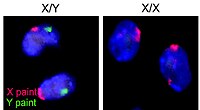
Photo from wikipedia
Metazoans exhibit two modes of primordial germ cell (PGC) specification that are interspersed across taxa. However, the evolutionary link between the two modes and the reproductive strategies of lecithotrophy and… Click to show full abstract
Metazoans exhibit two modes of primordial germ cell (PGC) specification that are interspersed across taxa. However, the evolutionary link between the two modes and the reproductive strategies of lecithotrophy and matrotrophy is poorly understood. As a first step to understand this, the spatio-temporal expression of teleostean germ plasm markers was investigated in Gambusia holbrooki, a poecilid with shared lecitho- and matrotrophy. A group of germ plasm components was detected in the ovum suggesting maternal inheritance mode of PGC specification. However, the strictly zygotic activation of dnd-β and nanos1 occurred relatively early, reminiscent of models with induction mode (e.g., mice). The PGC clustering, migration and colonisation patterns of G. holbrooki resembled those of zebrafish, medaka and mice at blastula, gastrula and somitogenesis, respectively—recapitulating features of advancing evolutionary nodes with progressive developmental stages. Moreover, the expression domains of PGC markers in G. holbrooki were either specific to teleost (vasa expression in developing PGCs), murine models (dnd spliced variants) or shared between the two taxa (germline and somatic expression of piwi and nanos1). Collectively, the results suggest that the reproductive developmental adaptations may reflect a transition from lecithotrophy to matrotrophy.
Journal Title: Frontiers in Cell and Developmental Biology
Year Published: 2022
Link to full text (if available)
Share on Social Media: Sign Up to like & get
recommendations!